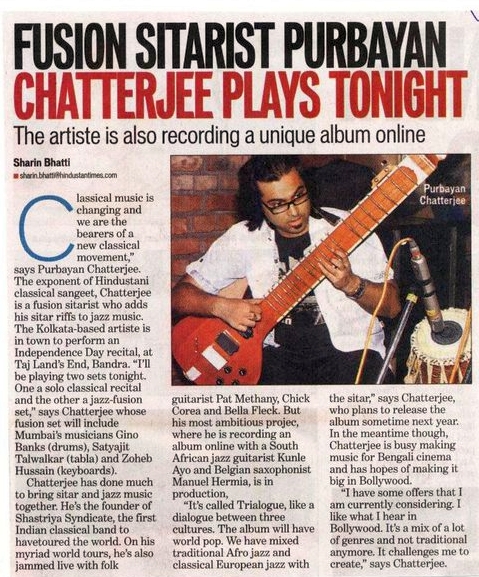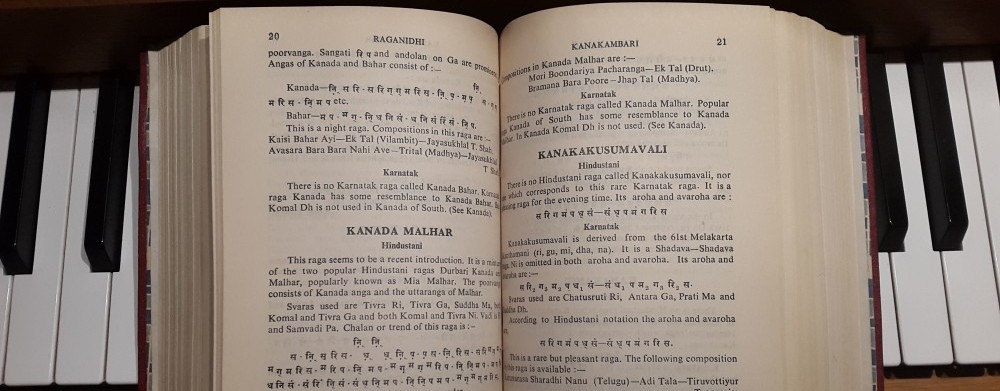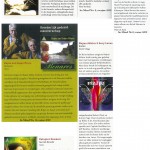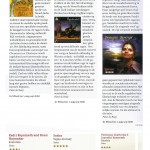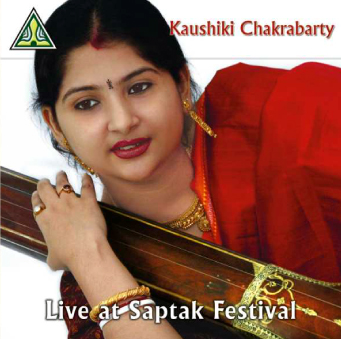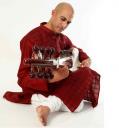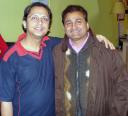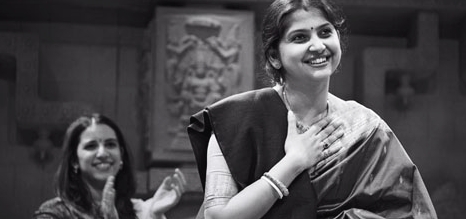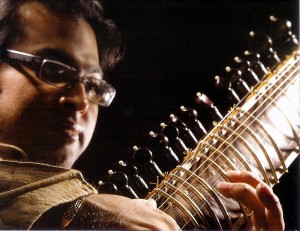
Op vrijdag 30 mei staat in mijn programma Gharana sitarspeler Purbayan Chatterjee uit Calcutta in de schijnwerpers. Hij wordt al zeker tien jaar als een van de absolute topsitaristen van India beschouwd, maar is toch nog maar 31 jaar, naar Indiase maatstaven een leeftijd waarop het beste van een artiest zich eigenlijk pas begint te manifesteren.
Purbayan Chatterjee behoort tot de befaamde Senia Maihar Gharana, de school rond het muzikale genie Baba Allauddin Khan (1862[?]-1972), guru van grootheden als z’n zoon Ali Akbar Khan (1922) op sarod, z’n dochter Annapurna Devi (1926) op sarod, Pannalal Ghosh (1911-1960) op bansuri en Ravi Shankar (1920) en Nikhil Banerjee (1931-1986) op sitar.
In het eerste half uur van het 90-minuten programma schets ik een muzikaal portret van Purbayan Chatterjee, aan de hand van een interview dat ik met hem had, begin april 2008 op het Darbar Festival in het Engelse Leicester, over z’n carrière en over z’n muziek.
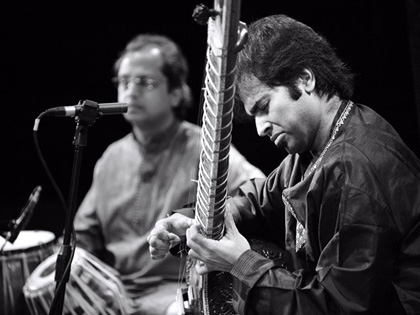
Purbayan Chatterjee op het Darbar Festival 2008 in Leicester ; photo by Arnhel de Serra *
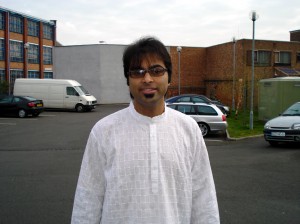
Purbayan Chatterjee in Leicester, Darbar Festival 2008 ; photo by Pieter de Rooij
Purbayan Chatterjee is een zeer veelzijdig muzikant. Naast concerten met Noord-Indiase ragamuziek speelt hij ook met muzikanten uit de Zuid-Indiase ragatraditie en participeert hij wereldwijd in allerlei fusionprojecten van diverse wereld- en jazzmuzikanten. In het muzikale portret is hij in al deze hoedanigheden te horen. Aan bod komt onder meer het recent door hem opgerichte Shastriya Syndicate. Dit ensemble van muzikanten uit de Noord- en Zuid-Indiase ragatraditie maakt de Indiase klassieke muziek veel toegankelijker voor een luisterpubliek dat niet gewend is om naar lange raga’s te luisteren.
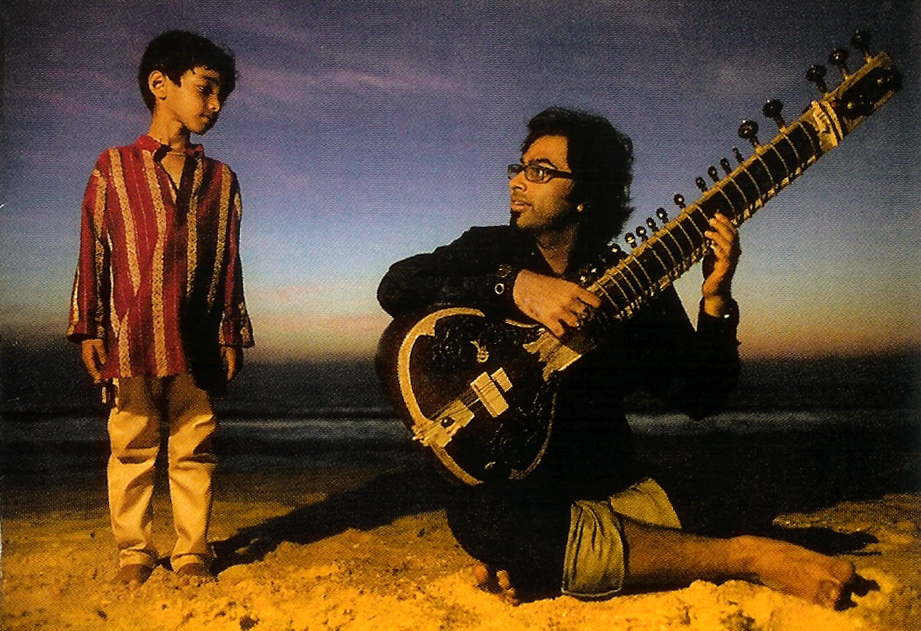
Albumhoes van Purbayan Chatterjee’s Shastriya Syndicate
Ook wordt ingezoomd op zijn duet-vertolkingen met veena-speelster Jayanthi Kumaresh, violiste Kala Ramnath en fluitist Shashank. De muziek en invloed van zijn vader Partha Chatterjee, ook sitarist, en van diens goeroe, de legendarische Senia Maihar sitarist Nikhil Banerjee, komen uiteraard ook uitgebreid aan bod. Naast zijn vader en Nikhil Banerjee is ook de legendarische sarod-gigant Ali Akbar Khan voor Purbayan een belangrijke inspiratiebron en guru.
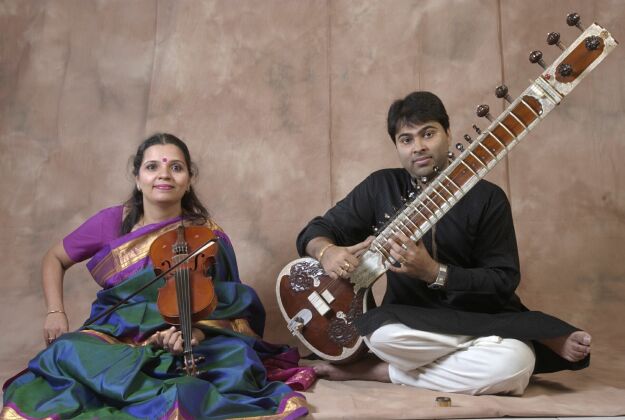
Violiste Kala Ramnath en Purbayan Chatterjee
Purbayan Chatterjee’s grote muzikale talent treedt al vroeg aan het licht en vanaf z’n vijfde krijgt hij sitarles.
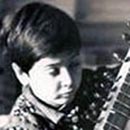
Purbayan’s eerste schreden op de sitar
Purbayan treft het dat hij via z’n vader Partha van heel nabij in aanraking kan komen met het spel van de legendarische sitarspeler Nikhil Banerjee van de Senia Maihar Gharana. Samen met Ravi Shankar en Vilayat Khan (1927-2004) behoort Nikhil Banerjee tot de Grote Drie van de Indiase sitar na India’s onafhankelijkheid in 1947. Behalve dat Nikhil Banerjee veelal wordt beschouwd als de beste van de drie, is zijn spel ook het meest melodieus en toegankelijk. Van Nikhil Banerjee is bekend dat hij geen les gaf, maar Partha Chatterjee blijkt een uitzondering.
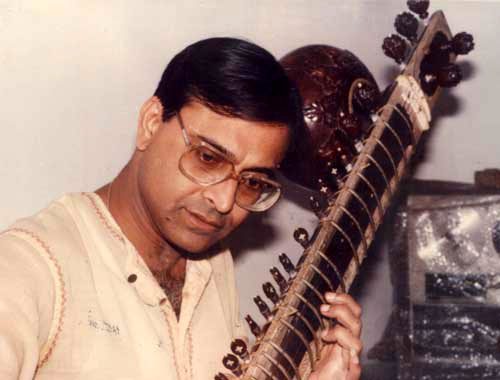
Partha Chatterjee, de vader van Purbayan
Purbayan’s vader brengt twaalf jaar intensief met Nikhil Banerjee door. Dat heeft deels ook te maken met het belangrijke secretarieel werk -zakelijke correspondentie etc.- dat hij in die jaren voor Nikhil verricht. Partha reist met hem de wereld over en krijgt in die periode dus ook, wellicht als enige sitarist, lessen van Nikhil Banerjee. Purbayan Chatterjee kan daardoor als kind -via z’n vader- de wereld van Nikhil Banerjee van dichtbij ervaren. Voor z’n tiende ontmoet Purbayan Nikhil Banerjee diverse malen in Calcutta en maakt hij kennis met het sitarspel van de maestro. In januari 1986 echter, als Purbayan 9 jaar is, sterft Nikhil Banerjee, slechts 54 jaar oud, aan een hartaanval. Zijn volmaakte techniek, de lyriek en de diep-meditatieve, introspectieve speelstijl hebben dan al een een onuitwisbare indruk gemaakt op de kleine Purbayan.
Purbayan’s werk volg ik al vele jaren en zijn cd-oeuvre behoort tot mijn favoriete ragamuziek. Hoe sterk in zijn spel de invloed van Nikhil Banerjee doorklinkt werd mij vorig jaar nog maar weer es duidelijk via een bevriende programmamaker van de Concertzender-wereldmuziekredactie, Henk Braaksma, een groot liefhebber van Indiase ragamuziek en in het bijzonder een groot kenner van Nikhil Banerjee, zijn favoriete sitarspeler. Hij had ooit het genoegen Nikhil lang geleden een keer bij hem thuis te ontvangen en kreeg toen en passant ook nog wat muzikale tips van hem cadeau (Henk speelt zelf Hawaii-gitaar).
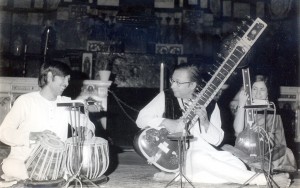
Nikhil Banerjee in de Mozes en Aäronkerk in Amsterdam
Toen Purbayan Chatterjee vorig jaar op een zondagmiddag in mei optrad in het KIT Tropentheater trof ik Henk daar ook. Hem vielen natuurlijk al direct overeenkomsten op in het spel van Purbayan -die hij nog nooit eerder had horen spelen- met het spel van Nikhilji. Flink onder de indruk kocht Henk na het concert van Purbayan Chatterjee diens album Talaash (2006). Enkele dagen later kreeg ik van Henk te horen, dat hij na thuiskomst van het concert nog diezelfde avond Talaash had beluisterd. Wat hij hoorde overviel hem. Het sitarspel van Purbayan bleek zo overweldigend mooi en deed hem zo sterk denken aan Nikhil Banerjee, dat hij al gauw, diep ontroerd, in tranen zat te luisteren.
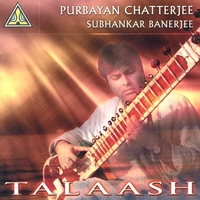
Het album Talaash
Zijn speelstijl roept inderdaad associaties op met Nikhil Banerjee, maar Purbayan Chatterjee is in de loop der jaren zijn eigen muzikale weg gegaan en heeft een zeer herkenbaar eigen geluid ontwikkeld. Wat ik prachtig vind aan Purbayan’s spel is zijn bijzondere vermogen om binnen de kleinste, door microtonaliteit bepaalde toonsafstanden, diverse klankkleuren te laten horen. Zelfs in de kleine bewegingen van de afzonderlijke ragatoon legt hij al een wereld aan klankkleuren bloot. Ongelooflijk mooi!
Purbayan’s sitarspel levert ook een fraaie balans op tussen de instrumentale en de vocale stijl (op vocaal gebied leerde hij met name veel van Patiala-zangmeester Ajoy Chakrabarty) en de wisselwerking tusen sitar en tabla laat ook niets te wensen over. Met name in de ‘gats’ (instrumentale composities) kun je volop genieten van Purbayan’s uitstekende timing en ritmegevoel, een aspect waar hij heel veel aandacht aan besteed en waarvoor hij -om dit perfect te beheersen- intensief studeerde op tablaritmes bij twee grootmeesters, Zakir Hussain en Anindo Chatterjee. Uit Purbayan’s opbouw en afwikkeling van een raga spreekt een afgewogen gevoel voor verhoudingen, waardoor zijn interpretaties een fraaie spanningsboog krijgen. Last but not least noem ik het melodisch vernuft en de glasheldere muzikale ideeën waarmee Purbayan Chatterjee zijn improvisaties vorm geeft. Zijn gloedvolle, met sustain-klanken doordesemde melodievoering leunt op een bondige, heldere frasering, waardoor z’n melodieën heel toegankelijk zijn. Hiermee toont hij zich wat mij betreft een soort Oosters equivalent van ‘onze’ componist Mozart** (ook een groot improvisator trouwens!), temeer omdat Purbayan zijn krachtige melodieën -net als Mozart- ook in talloze boeiende variaties laat horen. Er klinkt geen noot teveel, elke toon staat als een huis. Het is, hoe dan ook, geniaal.
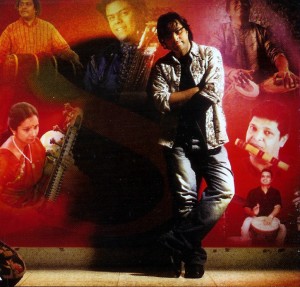
Purbayan Chatterjee
De zojuist geroemde kwaliteiten van Purbayan Chatterjee komen in de Gharana-uitzending op 30 mei het beste naar voren in een bijna drie kwartier durende uitvoering van de avondraga Puriya waarmee de uitzending wordt besloten. Deze raga is te vinden op het in 2006 verschenen album Talaash. Op Amazon.com besprak ik dit album onlangs heel kort als volgt:
“A not-to-be-missed gem amongst sitar-cd’s. Purbayan Chatterjee excells as ever and displays his matured mastership as he breathes life into the beautiful evening ragas Malgunji and Puriya, both full of serenity, grace, gratitude and fulfillment. In raga Puriya I also sense a mood concerned with a mysterious and rather overwhelming expectation of something precious that’s not really yet disclosed, but still evokes a feeling of bliss and happiness. Subhankar Banerjee’s contribution on tabla is excellent. The beauty is further enhanced -to a breathtaking level- through the superb recording by engineer/producer Derek Roberts. Whenever you play this music, you’ll be experiencing a blissfull evening. A totally rewarding and satisfying album.”
Ik denk dat Purbayan Chatterjee’s uitvoering van de raga ‘Puriya’ niet alleen de doorgewinterde ragaliefhebber maar ook de breed geïnteresseerde muziekliefhebber zal aanspreken. Van harte aanbevolen!
De Concertzender – Gharana – Het melodisch vernuft van Purbayan Chatterjee – vrijdag 30 mei 2008, 20.00-21.30u
* De foto’s zijn aanklikbaar en worden dan in een aantal gevallen groter weergegeven
** Deze vergelijking heb ik wellicht niet helemaal zelf verzonnen, 🙂 want freelance muziekjournalist Ken Hunt trok al eens eenzelfde vergelijking tussen de violiste Kala Ramnath en Mozart, in zijn review van het album Kala (2005) in het blad Jazzwise.
HOME
